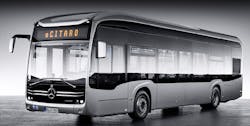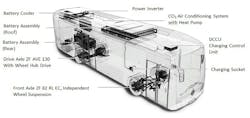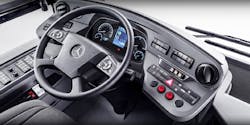The eCitaro, unveiled by Mercedes-Benz this year, is the company’s first all-electric production bus, an electric version of the company’s combustion-engine Citaro (Fig. 1). The eCitaro, expected to go on sale by the end of 2018, will be able to transport about 88 passengers, and will initially be a plug-in battery electric. Its batteries are modular, with six to 10 battery packs capable of providing up to a total maximum of 243 kWh.
1. The eCitaro is an all-electric version of Daimler’s combustion-engine Citaro.
The eCitaro’s electrical portal axle has a 400-V, water-cooled asynchronous motor on each wheel. The motors output 125 kW, for a total of 250 kW. The torque from a standstill is 2 × 485 Nm, and a torque of approximately 2 × 11000 Nm can be applied to the wheels thanks to the transmission ratio. The space gained by removing the combustion engine and gearbox provides room to house the battery modules. Figure 2 shows the bus details.
2. eCitaro employs a 400-V water-cooled asynchronous motor on each wheel, powered by a dc-ac inverter and its associated batteries.
Operating-range figures for all-electric-powered city buses are often difficult to compare since reference values can be missing and the figures have often been calculated under ideal conditions. In the interests of reliable data, Mercedes-Benz prefers to consider a "worst-case scenario" and takes its direction from the challenging standardized city driving cycle known as SORT2 (Standardized On-Road Test Cycles).
Mercedes‑Benz also adds the energy requirements of the ancillary consumers into the equation. According to SORT2, the eCitaro with a full complement of batteries should be able to achieve an operating range of around 150 km in the summer. Even without “opportunity charging,” the eCitaro covers about one-third of all requirements for transport operators
City buses obviously make regular stops along a route, providing drivers with the chance to quickly get off before moving to the next stop, perhaps using overhead cables or under-road wireless-charging installations. Even without making these "opportunity charging" stops along a route, Daimler believes that the eCitaro could already meet nearly a third of the route requirements of transport operators.
Future Batteries
With battery-development technology rapidly progressing, the eCitaro is already designed to transition to future battery technology. The next generation of the bus will then cover around 50% of all applications. This greater battery capacity also makes possible a meaningful introduction of an eCitaro G articulated bus with a reasonable range.
Additional development steps are already mapped out, including the use of so-called solid-state batteries, which are characterized by a particularly long service life as well as high energy density. With a rated battery capacity of about 400 kWh in the solo bus and even more in the articulated bus, the eCitaro will then meet about 70% of all requirements without opportunity charging.
With the maximum complement of 10 battery modules, the eCitaro in standard specification weighs around 13.44 tons. In conjunction with a gross vehicle weight rating of 19.5 tons, this corresponds to a payload of more than six tons, or about 88 passengers—in line with what’s needed during rush hour. The eCitaro's charging technology also allows it to adjust to the individual wishes and requirements of the transport operators. Figure 3 shows the battery modules.
3. Lithium-ion batteries are divided between as many as 10 modules, each supplying about 25 kWh.
Charging the batteries makes use of a Combo 2 plug, which the European industry favors as standard. It’s communication-capable and suitable for high charge outputs and quick charging (combined charging system, or CCS). It permits charge outputs of up to 150 kW and current up to 200 A.
Battery capacity alone provides little indication of the actual performance capability and, above all, the range of an all-electric city bus—the true measure is energy consumption. In the case of a city bus, this is impacted significantly by climatic conditions, which thus means the need to cool and, above all, heat the interior.
Thermal management of the eCitaro received special mention. The high-efficiency climate-control system works with CO2 as a refrigerant; a heat pump heats or cools the passenger compartment. All components dissipating heat are inter-linked and the temperature control is based on the number of passengers on board.
Compared with the combustion-engine Citaro, the eCitaro’s energy requirement for heating, ventilation, and climate control drops by about 40%, with a simultaneous increase in range. Daimler says that those savings should translate to a worst-case range of 150 km (93 mi.) in the summer months between charges. Under ideal conditions, this increases to 250 km.
Fuel-Cell Range Extender
Eventually, the eCitaro range may be increased by a fuel-cell range extender. The fuel cell will allow the eCitaro to fulfill nearly 100% of all requirements on city buses. This technology eliminates the need for opportunity charging and the complex infrastructure required for it in almost all cases—the eCitaro will be able to replace city buses with combustion engines virtually one-to-one.
The eCitaro has assistance systems intended to unburden the driver and protect more vulnerable road users, which can save lives:
- Active Brake Assist 4 warns driver visually and audibly of any potential collision with pedestrians and at the same time automatically triggers partial braking. The driver can warn the pedestrian using the horn, initiate maximum full-stop braking, or steer to avoid the collision.
- Preventative brake assist issues a warning before a collision with standing or moving objects. If there’s an acute danger of a collision, it automatically initiates a braking operation with partial braking. This feature uses a new generation of radar technology that scans traffic up to 250 meters ahead of the bus.
- Safeguard assist helps the driver recognize critical situations when turning. In the first stage it warns the driver, and in the second stage it emits an additional warning. It also warns of stationary objects in the turning curve.
Among the other features on this bus are:
- Acceleration slip regulation (ASR) prevents wheelspin when driving on a slippery road. It provides no more power than the drive wheels area is able to transfer to the road surface.
- Anti-lock braking system (ABS) distributes braking forces acting on the individual wheels so that even in an emergency braking situation, no wheel is blocked for any length of time and the steering performance of the bus is largely maintained.
- Lighting that includes cornering lights and headlamps. The fog lamps on the inside of the bend are steered so that road ahead is illuminated better. The cornering light switches on automatically up to a speed of 40 km/h.
- Eco Driver Feedback (EDF) provides the driver with individual feedback on his or her personal driving behavior. The objective is exploit every potential in terms of fuel-saving.
- Electronic level control automatically regulates the vehicle height at each wheel so that the step height is always the same. Passengers and luggage aren’t always distributed in the vehicle, so the height of the vehicle varies from wheel to wheel.
- Electronic Stability Program (ESP) selectively controls engine output and braking forces at each wheel individually. ESP contributes noticeably to a reduction in the tendency to understeer and risk of skidding during cornering or evasive maneuvers.
- Electropneumatic Braking System (EBS) is a further development of the conventional air brake and offers numerous advantages. EBS results in much shorter stopping distances and significantly less wear on brake linings and discs.
- Evo Thermatic Plus system provides fully automatic climate control in the interior.
- In addition, there’s a tire pressure monitoring and the electrohydraulic steering system. Electrically operated in-swinging doors lead into the passenger compartment, complemented by a manually operated folding ramp at entrance 2.
Passengers are seated on "City Star Eco” seats produced in-house. The upper sections of the seat shells are dyed black, while the seat cushions and seatbacks are covered with the striking "Flash" upholstery fabric. Vertical handrails in Evo Steel, black ceiling handrails, and blue metallic stop request buttons add visual highlights on the grey floor with pebble design. Passengers are provided with information on a large 29-in. TFT screen. They can operate their own end devices on 13 dual USB ports.
4. Drivers can control the heating and cooling as well as the doors. There’s also a power meter that shows the energy flow of the eCitaro.
The driver's area of the eCitaro has a separate climate-control system (Fig. 4). In addition, the driver sits on a climate-controlled seat. A power meter displays the current power demand and/or energy-recovery rate. The driver also receives information about the state of charge of the batteries. He can access the range, available power, and a charging indicator on the central display.
Omniplus On Digital Service
Service for buses and coaches becomes digital with Omniplus On, opening up entirely new possibilities for bus operators and drivers thanks to connectivity. Digital services are bundled in a clearly arranged way on the Omniplus On internet portal, which initially rests on three pillars.
The Omniplus On advance ensures maximum fleet availability for bus operators. For example, the Omniplus Uptime service continuously monitors the relevant vehicle systems in real time. Data is continuously analyzed and interpreted. If there are impending severe technical malfunctions, the bus operator is immediately informed by Omniplus 24h Service, together with recommended actions to prevent a vehicle breakdown.
The Omniplus On monitor combines the telematics services, such as Fleetboard in addition to Omniplus Uptime, for efficient fleet management. And its drive ensures the communication between the driver and the company, as well as helps the driver with, say, the required daily departure check.
Furthermore, the Driver’s App supports the driver and operator during the prescribed pre-departure check and with communication, while Remote Bus makes important data available.






